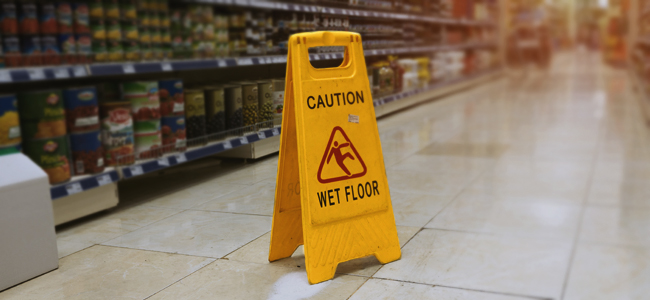
Suing for a Supermarket “Slip ‘n Trip” – What Must You Prove?
“The path is smooth that leadeth on to danger” (William Shakespeare)
Tripping over aisle blockages or slipping on floors made slick by spillages can happen in even the best-managed supermarkets, and injured shoppers regularly turn to our courts to claim damages from shopkeepers and building owners.
It’s no surprise therefore that this sort of claim has its own (informal) name – the “slip ‘n trip” case. A recent High Court judgment provides some clarity on what you will need to prove should you be one of the unfortunate shoppers who are injured in this way.
A shopper slips, and sues
- A shopper slipped on an unidentified spillage, injuring herself and needing hospitalisation and further treatment for unspecified orthopaedic injuries.
- Supermarket employees initially undertook to cover her medical expenses but later the supermarket denied liability.
- It admitted that it had a “general duty of care to customers visiting its store to ensure that it afforded them a safe environment within in which to shop”, but claimed the shopper’s fall was “due to her sole negligence in that she failed to keep a proper lookout, failed to take reasonable steps to prevent her fall and failed to avoid injury to herself.” In the alternative it alleged contributory negligence on her part. It also sought to blame its cleaning service contractors and/or an independent merchandiser who had been working in the aisle in question.
- The shopper took her claim for damages to the High Court, which confirmed that what you will have to prove is that the shop –
- Should have foreseen the reasonable possibility of its conduct causing your injury and monetary loss; and
- Should have taken reasonable steps to avoid that loss; and
- Didn’t do so.
- Should have foreseen the reasonable possibility of its conduct causing your injury and monetary loss; and
- The Court held that, on the evidence presented, the shopper had proved that “she took proper care for her own safety on the morning in question. The fact that she may have moved down aisle 5 at more than a leisurely dawdle did not occasion her fall: she did not slip or trip because of haste or inattention but because she stepped in some spillage of unknown origin.” (i.e., you need to prove you weren’t negligent)
- And even if the spillage was a small one (supposedly the size of a R2 coin in this case) “it really matters not what the extent thereof was as its mere presence on the supermarket floor presented a risk to any unassuming shopper, who would be expected to spend her morning looking at the merchandise on the shelves and not peering down at the floor ahead of her.” (i.e., keeping a proper lookout doesn’t necessarily mean peering down at the floor ahead of you all the time)
- In principle, once a shopper has “testified to the circumstances in which he fell, and the apparent cause of the fall, and has shown that he was taking proper care for his own safety, he has ordinarily done as much as it is possible to do to prove that the cause of the fall was negligence on the part of the [supermarket] who, as a matter of law, has the duty to take reasonable steps to keep his premises reasonably safe at all times when members of the public may be using them.”
- The shopper in this case had done all that, raising a rebuttable presumption of negligence by the supermarket so that, in the absence of an explanation from it, it was inferred that a negligent failure on its part to perform its duty must have been the cause of the fall. In this case it provided no evidence of how long the spillage had been on the floor or how long it was reasonably necessary for it to discover the spillage and clean it up. (i.e., once you prove what happened and that you took proper care for your own safety, it’s for the supermarket to prove that it wasn’t negligent)
- The shopper is entitled to whatever level of damages she can prove.
Provided by Woodhead Bigby Inc. Attorneys
© DotNews. All Rights Reserved.
